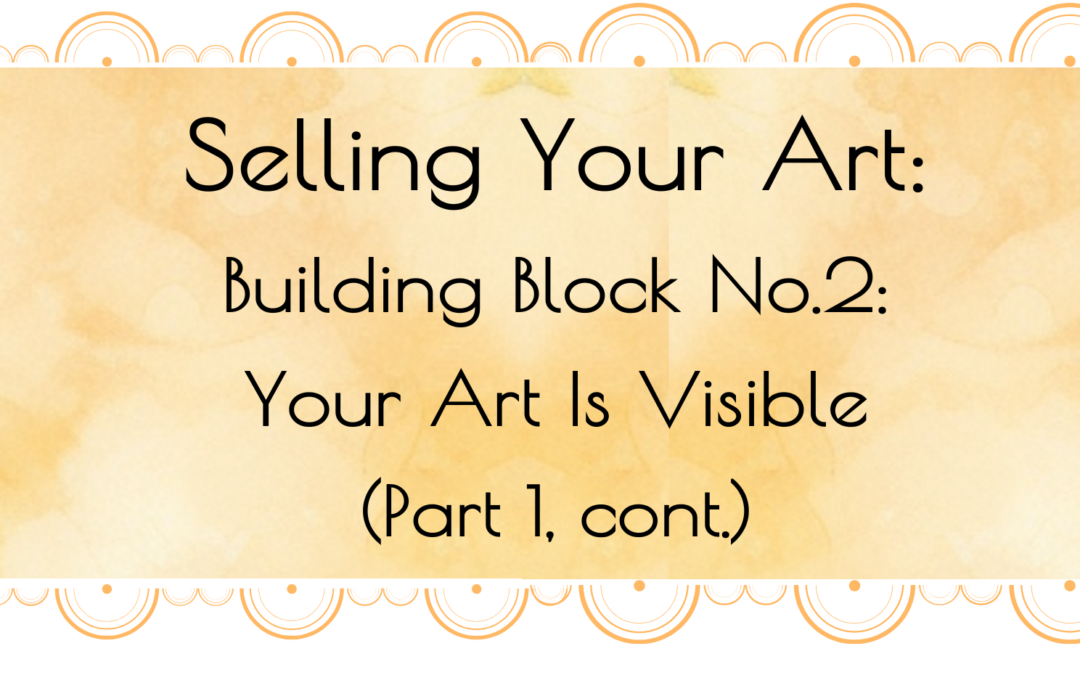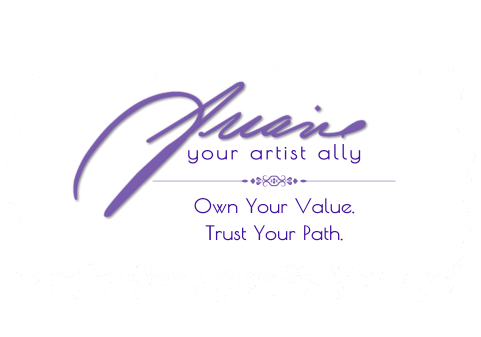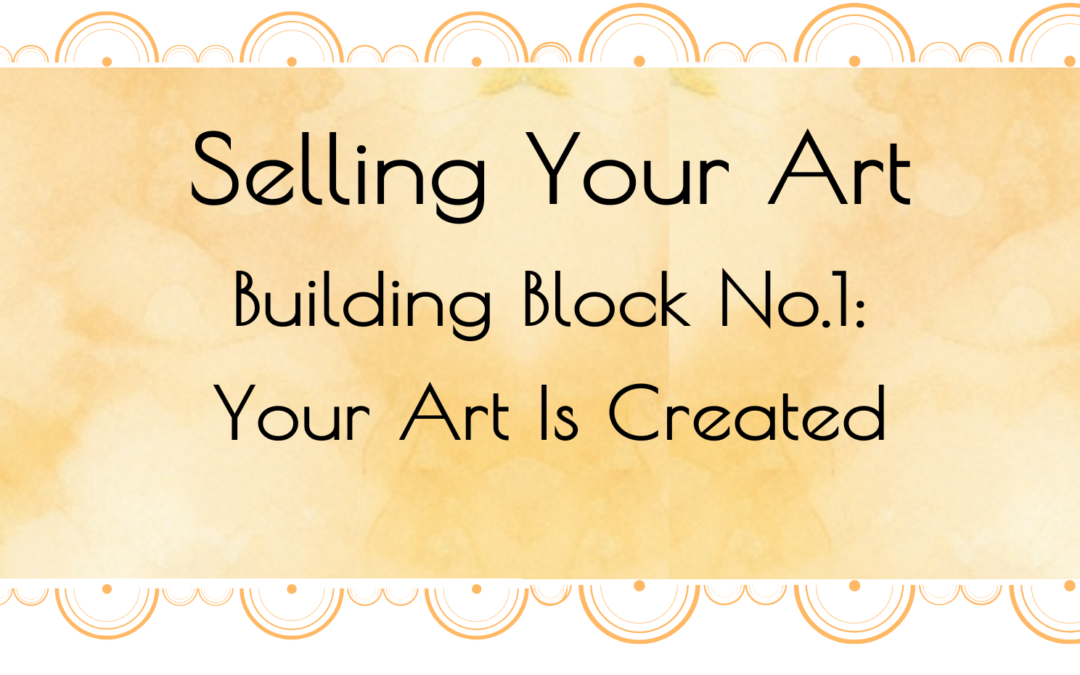
Selling Your Art: Building Block No.2: Your Art Is Visible (Part 1, cont.)
Let’s do a quick review of last week’s Selling-Your-Art Building Block No.1 and Selling-Your-Art Building Block No.2 (Part 1)
Selling-Your-Art Building Blocks Recap
Selling-Your-Art Building Block No.1: Your Art Is Created:
This is a foundational building block, which needs your attention in three key areas:
- You’re putting in the time and effort to reach a certain level of skillfulness.
- You’re establishing your artistic fingerprint, your unique artist angle.
- You’re reaching deep into your creative spirit and manifesting a creative truth for the world to experience.
Selling-Your-Art Building Block No.2 (Part 1): Your Art Is Visible
This might seem too obvious to bother with, until you consider all the ways your art might be functionally invisible. This can run the gamut from not being visible at all, to being visible, but inaccessible.:
- Your website contact form doesn’t work (and you don’t know this because you don’t email yourself—on a regular basis—from that same form!).
- You lost a gallery and haven’t worked yourself up to move on.
- Your website is a ho-hum, portfolio-only menagerie of your work.
- You truly think words don’t matter, so no artist statement and a boring bio.

Are You Unintentionally Blocking The Visibility You Need For Selling Your Art?
If you are already a professional artist selling your art, or you are heading in that direction, you realize how essential it is to be the sensitive creative you are, and a pragmatic, life-long learner.
You realize that the truth and power of your art, and thus the truth and power of selling your art, rests on more than the surface-level, nitty-gritty, administrative and marketing tasks.
As important as these daily, weekly, monthly external tasks are, they can also be the barrier to paying attention to the less obvious, emotional and spiritual capacities of our internal experience.
It’s this rarely explored, internal territory with its exotic fauna and flora that underpins what determines how you sell your art, because it determines the most basic relationship you have: your relationship to your art.
And your relationship to your art is what pulls the invisible strings of success for selling your art. I go into this in depth in my artist manifesto: Your Path of Visionary Affluence: A Manifesto for Artists who want to sell more art.
When you don’t pay attention to the internal stories you whisper to yourself, they control your internal experience in the same way an out-of-control child wreaks havoc in a grocery store because the caretaker isn’t paying attention.
The key is being psychologically strong enough, and intellectually willing enough, to be wrong from time to time. Or willing to experience emotional discomfort from time to time, without putting your hair on fire.
Otherwise, you may be unintentionally blocking how visible and accessible your artwork is, and then passing this off with “I forgot.” Or, “I didn’t know.” Or (my favorite), “I didn’t mean to… (fill in the blank).”

When Your Art is Visible, You Are Visible. And Selling Your Art is the Most Visible of All.
But, how do you know which old triggers are keeping you from selling your art because its visibility and accessibility is compromised?
For a lot of creatives, being visible is a double-edged sword. We crave it, on the one hand; while being skeptical and cautious on the other.
The joys of being visible means we’re on the road to success. We’re seen—the holy grail of human desire. The artwork we love is in the world and for the world, and what could be more satisfying?
And… selling your art is the culmination of creative work and the ultimate joy of visibility.
Meanwhile, in the underground of our psyches, visibility can also dredge up all shapes and sizes of triggers related to early trauma. From the belittling remarks of classmates to terrifying nights with a drunk parent, a good many of us have experienced life in ways we do not wish to repeat.
And even though we’ve historically grown way past those incidents, they often live on in the crevices of our bodies, and pop out when the trigger conditions are right. For most of us, this happens on the QT, buried beneath the more urgent, daily tasks of living.
If we don’t become aware of our visibility triggers, then they quietly slash and burn our art careers in ways our daily Creative Self doesn’t see. And selling your art becomes the casualty.

So, what do we do with this? I mean, isn’t a trigger out of our control?
Yes… and No.
An emotional trigger just happens. No control here. The trick is what you do after the trigger shows up.
First, notice the visibility trigger that just happened.
Your clue will be somewhere in your body where a major shift occurred: your stomach lurched / your headache started / your shoulders tightened / your jaw clenched.
This body reflex will be consistent for each trigger; it doesn’t change until you become aware and awake.
Next, once you’ve identified your physical reaction to your emotional trigger, ask yourself: What’s going on here?
And listen for a response, which might not turn up right away. But that’s okay. If you follow noticing your body’s specific response to the trigger with the question– What’s going on here?—over time you’ll become aware of the connection to something that happened to you before.
The key is both self-kindness and self-respect. You’re doing this to strengthen your internal ability to allow your art to be completely and wholly visible so selling your art doesn’t hit any speed bumps.
This is not the time for blame or ridicule or self-criticism. It’s only time to become aware and awake so selling your art becomes a joyous success.
Alongside visibility triggers is another tricky pattern of behavior I’ve identified as The Gap.

Selling Your Art: Building Block No.2: Visibility (Part 2)
Most of us experience The Gap on any given day as an unconscious, socially acceptable response to some mis-step we’ve taken. In most cases, it’s not worth paying attention to.
However, in some cases it can, inadvertently, derail the visibility you need for selling your art. But, this is tricky territory, as you’ll see, because as far as I know, no one has dug into this common, human pattern of behavior to understand it’s true nature.
In fact, this behavior is so common it’s dismissed out of hand. And this is one of its greatest feats: hiding a deceptive deflection behind a familiar, innocent sounding refrain…
I’m sorry… I didn’t intend to… (fill in the blank).
But, there is a way out of this coverup.

It’s rare when we take the time to examine the interplay between our external reality and our internal landscape.
And yet, dialogue between these two realities pretty much determines how we move through the world: what art we make, how others perceive who we are and what we do, and how we perceive ourselves.
It’s also the disconnect between our external behavior and our internal intentions that get us into trouble.
This common remark—“Yes, but I didn’t intend to do xxx (fill in the blank).”—is hiding an ego-generated reaction (in a moment you’ll see why I call it that) that poses as a rationale for behavior that has, to some degree, troubled the person on the receiving end of the behavior.
“Yes, but I didn’t intend to (fill in the blank)…” is, in reality, always a cleverly disguised excuse.
First, consider that the behavior (whatever it is) has actually happened. It’s a done deal. No taking it back.
A Couple of Not-So-Fun Examples Where Internal & External Realities Collide
You accidentally knock over your friend’s water glass and it spreads over the painting she’s been working on for weeks.
Of course, you didn’t mean to. But how does that change the hours of work she can never get back?
Or, blissfully unaware that the gallery owner can hear you, “She just won’t stop yammering!” becomes a hot moment you can’t take back. I didn’t intend to hurt her feelings has zero impact on feelings already hurt.
As bad as you might feel, “I didn’t intend to do that” does not, nay…cannot mend fences.
Why?
If you uncloak the “rationale” of this reaction, you will find a scared, ego turning the spotlight away from the (mis)behavior and the person affected, and onto the ego itself as the real victim of… of all things…an intention.
I didn’t intend is a way to avoid responsibility for the result of some behavior by implying a kind of innocence behind the behavior that should be the real factor considered.
So, what’s really going on here?

And why is The Gap relevant to Selling Your Art: Building Block No.2?
Most of the time, most of us are oblivious to the disconnect between what we are experiencing internally and our external behavior.
We assume, 99% of the time, that whatever we are experiencing internally (the home of all intentions) is automatically showing up in our behavior. And, of course we also assume that anyone else can see this is true.
Sometimes these two distinct, yet constantly intertwined realities are aligned. What you experience internally is manifesting in your external behavior. And that makes for smooth sailing.
But a good deal of the time, there is a gap between the two. And this gap can be a one, on a scale of 1 to 10, or a ten—or anywhere in-between.
The problem is, it’s very hard to know how much of a gap is manifesting (or if there’s any gap at all) by ourselves.
It’s as if the Divine Order of Things has decreed that “the eye cannot see the eye” as a clue that we need each other. That cooperation and connection trumps isolation and disconnection.

So, then, what to do when selling your art is on the line…
because you’re struggling with a collector, buyer, gallery owner, or another artist?
Here’s a five-step, Map The Gap Process that’s easy to learn and apply:
First, check out, with yourself, if the bumpy interaction might be exacerbated by your unawareness of the gap between your intention (internal experience) and your behavior (external manifestation).
Second, trust yourself. Self-honesty is a hard-won trait that can breathe life into any tangled knot.
Third, firmly (internally) tell your ego to: Please take a back seat (climb a tree, go read at the library, etc.). I’m happy to let you back in afterwards, but for now, I need my space—go!
Fourth, trust the other person. People rarely back away from a genuine, heartfelt plea for help or an apology given sincerely. So, ask the person in the tangle with you, I’d love the truth right now: how do you interpret what I am saying and doing?
Fifth, listen to the other person. To keep it safe and simple, only do this with one person at a time. Group dynamics can be dicey when you’re learning to work with your ego instead of against it.
Okay, this has been a lot.
Map The Gap: Let’s review the dynamic connection between your art’s visibility and selling your art.
When you’re faced with an art sale that has just slipped through your fingers. Or a time when you are trying to put your art in the world and you keep hitting roadblocks with other people. Or you’re working on a commission with a difficult client, see what happens when you apply the five steps in Map The Gap.
Because most of the time, most of us feel that whatever we are experiencing internally is naturally aligned with our behavior, we fail to check it out.
But if we do, and if we Map the Gap, suddenly there’s a release in any tangled knot of circumstances for us to:
- a) Recognize that our behavior is not honoring our intention accurately
- b) Address the gap with the person involved
- c) Mindfully create behavior that reflects the truth of your intentions
When did you last experience The Gap and it’s consequences?
I’d love to know, so please leave me a comment.
















